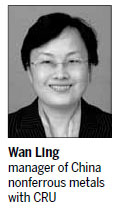

Although China began its trying to curb overcapacity in the primary aluminum industry in 2002, its efforts went nowhere. More than 80 percent of the current facilities were built since the capacity-cutting campaign began.

The underlying reason is that GDP has been the key indicator in the performance appraisals of local government officials.
The new government put capacity control among its top priorities. For instance, it stressed the importance of controlling overcapacity at the first meeting of the new Political Bureau of the Communist Party of China Central Committee in December 2012.
Crucially, with pollution becoming an increasing concern across China, the central government has stressed that there is an unprecedented urgency about environmental protection in China.
The central government told financial institutions to stop funding projects in industries with overcapacity, including aluminum, which was a break with the past.
However, actually controlling new capacity still depends heavily on actually implementing existing policies.
Our understanding is that if the projects have already started construction, the expansions are very likely to go ahead.
Thus, the new drive to curtail capacity is likely to have a small impact in the short term and little if any impact in the medium and long term.
And despite the tight credit for overcapacity-related projects, it is also worth noting that most of the new projects are being built in northwest China. Those projects are quite competitive in terms of power tariffs and energy resources, compared with the existing aluminum smelters in central and eastern China.
More than 80 percent of the greenfield (where no similar facilities exist) and brownfield (where a facility is converted or upgraded) primary aluminum projects are planned or under construction in northwestern China. This means the new projects are usually low-cost producers.
As a result, trading houses are willing to sign offtake agreements with these facilities covering future production, which does help the projects get financed to some extent.
Chinese aluminum capacity is likely to continue to grow by 2 to 3 million metric tons annually in the next few years.
Most of the new projects continue to be built in northwestern China, including the Xinjiang Uygur autonomous region, Gansu province and the Inner Mongolia autonomous region.
We do believe there will be very few primary aluminum projects in China after 2020, however, due to the capacity controls pursued by the new government.
The author is manager of China nonferrous metals with CRU, an independent commodity information provider.